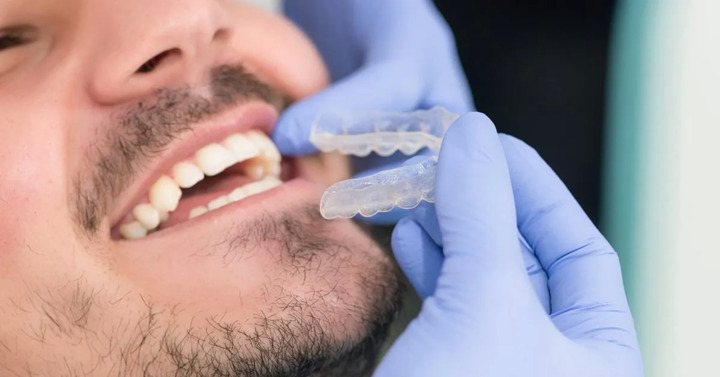Are you considering getting Invisalign and want to know more about it before you start? Here’s a guide to the Invisalign process and FAQs.

It’s no wonder people want to have straight teeth! 29% of Americans first notice someone’s smile.
A straight smile is often thought of as a sign of success.
Getting straighter teeth may be intimidating for some people, but with Invisalign, the process is very straightforward and easy.
If you’re considering fixing your crooked smile, keep reading to see if Invisalign is the right choice for you.
What is Invisalign?
Traditional braces are made of metal and create discomfort for the patient.
If you want to avoid metal braces, your dentist may recommend Invisalign, meaning it’s an entirely different approach to straightening teeth.
Invisalign are clear plastic aligners that are custom-fit to you and work to move crooked teeth into a straighter, more favorable position. The aligners are comfortable and nearly invisible compared to metal braces.
What’s The Invisalign Procedure Like?
If you decide Invisalign is something you want, the first step is to
speak with your dentist to determine if you’re a candidate for Invisalign. When your orthodontist clears you for Invisalign, they will set up an appointment to help you understand what to expect.
Here are some things you need to know about the Invisalign process.
1. After your initial consultation, the orthodontist will need a better understanding of the issues they need to fix concerning your teeth. They will take x-rays, molds, or impressions so they can create a treatment plan for you.
2. Once the orthodontist has determined your treatment plan, they begin building a sequence of aligners. These aligners will change every two weeks or more during your treatment. The goal of swapping these aligners is to keep the teeth shifting to the best position one small step at a time.
3. Your first set of aligners will need to be set by the dentist to ensure a proper fit. When the dentist is happy with the fit, they will show you how to use them and explain how to properly care for the aligners, such as cleaning and storing them.
4. As your treatment progresses, your orthodontist will want to see you every 4-6 weeks for a follow-up appointment to ensure your teeth are moving as planned. If they need to, they can tweak the process during your appointments.
5. You must wear the aligners exactly as the orthodontist prescribed and show up to each appointment. Doing so keeps your treatment on schedule. If you stop wearing your aligners for a time, you will add more time to your treatment.
6. If you’re faithful to your treatment plan, following all instructions, wearing all aligners in order then your teeth will be straightened! However, post-treatment your orthodontist may instruct you to wear Invisalign retainers.
7. You’re done! You may still have appointments with your orthodontist as they ensure the end treatment is working or if they need to make adjustments.
How Long Will I Need to Wear Invisalign?
In general, you will wear the aligners for 20-22 hours per day, but they are removed for activities like eating, drinking, and brushing your teeth. Everyone’s treatment timetable will vary, but a typical time for having Invisalign is one to two years depending on the severity of your teeth.
Teeth have a natural tendency to shift back into their original position after they’ve been moved. Invisalign retainers ensure your teeth stay in place, so all the work you’ve done isn’t undone.
Pros to Invisalign
There are many advantages to choosing Invisalign to fix your smile.
- Invisalign retainers are invisible making the fact that you’re receiving treatment almost impossible to notice
- The aligners are comfortable (with a slight discomfort once you begin) compared to metal braces which can cut gums are cause pain
- Invisalign can be removed which can lead to healthier teeth because you can brush and floss normally
- Fewer visits are needed because most of the work is done at the beginning of your treatment and you change your aligners at home
- Metal braces can cause damage to teeth and gumline, but Invisalign has a lower risk of damage
- While the duration of Invisalign depends mostly on the patient following the treatment plan, the time it takes to complete the treatment is less than metal braces
- Maintaining Invisalign retainers is relatively easy to do with a bit of scrubbing
Questions About Invisalign
With any medical procedure, there are always questions! Here are some questions that people typically ask about Invisalign.
Is Invisalign for everyone?
To be a good candidate for Invisalign, you must be self-disciplined in wearing the aligners and following your orthodontist’s directions. Invisalign works well for crooked teeth, but severely crooked teeth may need other dental interventions. Invisalign’s primary purpose is to correct teeth and not jaw complications.
Are There Any Side Effects?
Invisalign is not a medication, though there are rare occurrences of an allergy to the plastic. An allergy can happen with irritation on the gums. If this happens, contact your dentist so they can make adjustments.
Can Teenagers Use Invisalign?
Yes! As long as they have all their adult teeth, Invisalign is an option for teenagers. It’s preferred because of the social anxiety associated with having metal braces.
Will You Choose Invisalign?
Invisalign is an excellent alternative to metal braces.
Because of their comfort and convenience, Invisalign is a highly-desirable and highly sought-after dental procedure. Now that you understand the process, you can choose if you want to pursue Invisalign!
Do you still have unanswered questions about Invisalign or how it works?
Contact our office today to schedule an appointment!

